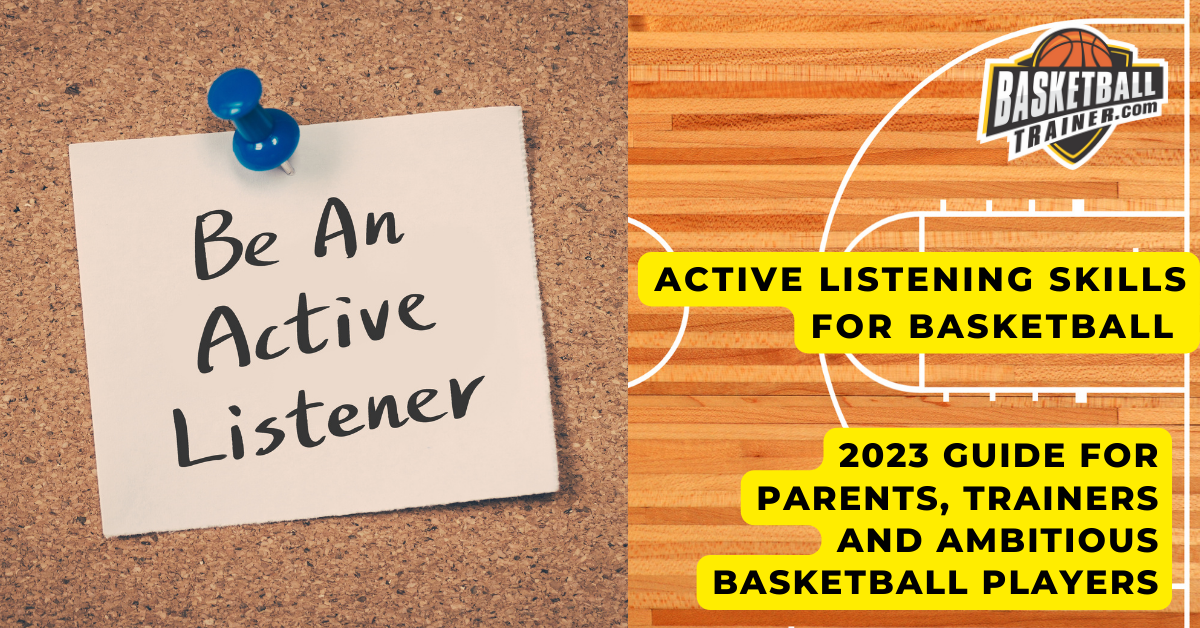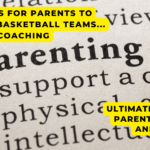
Picture this: You’re on the basketball court, and your coach is giving crucial instructions for the upcoming play. Active Listening in Basketball can make or break a game-winning moment.
But are you truly absorbing those vital tips?
In today’s fast-paced world, it’s easy to overlook the importance of being an active listener. However, developing your ability to listen attentively can have a major effect on not only how you play basketball but also the connections with teammates and coaches.
This post will explore the importance of Active Listening in Basketball, delving into its significance, strategies for achieving it and how to use these techniques both on and off the court.
We’ll explore strategies for preparing yourself mentally before engaging in conversation, displaying genuine interest and empathy towards others’ perspectives while maintaining eye contact and reading body language cues effectively.
Finally, we’ll provide 12 specific steps that ambitious basketball players like yourself can follow to become an active listener who commands undivided attention from their peers during pivotal moments in games or practice sessions alike!
Ready? Let’s dive into mastering Active Listening in Basketball together!
Table of Contents:
- Harnessing the Power of Active Listening
- Understanding Active Listening: Core Elements and Differentiation
- Preparing for Active Listening
- Showing Genuine Interest and Empathy
- Practicing Non-Verbal Communication
- 12 Specific Steps to Become an Active Listener on and off the Court
- FAQs in Relation to Active Listening in Basketball
- Conclusion
Harnessing the Power of Active Listening
Let’s dive right in.
To truly excel in basketball, you need to master more than just physical skills. One crucial aspect often overlooked is active listening. Exploring how utilizing active listening techniques can bolster individual and collective court performance is the subject of this section.
Why Active Listening Matters in Basketball
You might be wondering: “What does active listening have to do with basketball?” The answer is simple: communication is key for any successful team sport. Active listening helps teams strategize better, adapt quickly during games, and foster a positive atmosphere that promotes growth.
The Impact of Active Listening on Individual Performance
Beyond teamwork benefits, active listening plays a vital role in personal development as well. Ambitious basketball players who actively listen to their coaches’ feedback are more likely to understand instructions clearly and make necessary adjustments faster.
Active Listeners Make Better Teammates (and Leaders.)
Moreover, teammates who practice active listening tend to develop stronger bonds with each other – leading to increased trust and collaboration on the court. So honing your active listening skills could pave your way towards becoming an inspiring captain or coach someday.
Ready to level up your basketball game by becoming an active listener? Stay tuned as we dive into 12 specific steps that will help you unlock the full potential of active listening in both individual and team performance.
Understanding Active Listening: Core Elements and Differentiation
Let’s dive into the fascinating world of active listening.
To grasp what active listening is and how it contrasts with passive listening, we must explore further.
Active listening is a communication technique that involves fully focusing on, understanding, responding to, and remembering what someone else is saying. Rather than merely hearing the words, active listening involves paying attention to both verbal and non-verbal communication.
In contrast, passive listening means merely hearing the words without truly engaging or processing them.
Core Elements of Active Listening
- Focusing: Give your undivided attention to the speaker. This includes maintaining eye contact and avoiding distractions like checking your phone or daydreaming.
- Understanding: Grasp not only the words but also their meaning in context. Try putting yourself in the speaker’s shoes for better comprehension and listening skills.
- Responding: Offer verbal cues (e.g., “I see,” “Uh-huh”) and non-verbal gestures (nodding) that show you’re engaged with what they’re saying. Ask open-ended questions for clarification when needed.
- Remembering: Retain key points by mentally summarizing them during pauses in conversation or taking notes if appropriate.
Differentiating Between Active and Passive Listening
Active listening is a crucial skill for ambitious basketball players, their families, basketball training business owners, and basketball coaches. By actively listening to coaches, players can improve their skills and performance on the court. Passive hearing can lead to confusion and squandered chances for progression.
Now that we’ve established a solid foundation of active listening knowledge, let’s explore how you can apply it in basketball settings.
3. Preparing for Active Listening
Let’s begin our discussion of active listening in basketball.
To truly master active listening in basketball, you must first set the stage for success. Here are some practical tips to help you create a conducive environment and minimize distractions:
- Create a comfortable space: Ensure that both you and your conversation partner feel at ease by choosing an appropriate setting with minimal noise and interruptions.
- Put away distractions: Silence your phone, close unnecessary tabs on your computer, or even find a quiet corner of the gym – whatever it takes to stay focused.
- Maintain an open body posture: Show that you’re receptive by uncrossing your arms, leaning slightly forward, and keeping eye contact (more on this later).
- Breathe deeply: Deep breathing can help calm nerves and sharpen focus before engaging in meaningful conversations.
The key is to be fully present during these interactions so that nothing goes unnoticed or misunderstood. As an active listener, you need to have good listening skills and give your undivided attention to the speaker. Pay close attention to the speaker’s physical cues and gestures, as they can communicate just as much information as their spoken words. Being an active listener is an important skill that can help you both on and off the court.
Minimizing Distractions: A Real-Life Example
Ambitious basketball players like yourself know how crucial team huddles are for strategizing plays and discussing adjustments during games. In such high-pressure situations where every second counts, minimizing distractions becomes paramount.
By taking these straightforward yet effectual steps, you can be on your path to being an attentive hearer in both the game and beyond. Remember: practice makes perfect.
Ready for more? Check out our comprehensive guide on Active Listening in Basketball here.
Key Takeaway:
To master active listening in basketball, create a comfortable space, put away distractions, maintain an open body posture and breathe deeply. Pay attention to non-verbal communication and body language as they can convey just as much information as words. Minimizing distractions is crucial during team huddles for strategizing plays and discussing adjustments during games.
4. Showing Genuine Interest and Empathy
Empathy is a key ingredient in building strong connections with your teammates and coaches. Research shows that empathy fosters trust, cooperation, and understanding – essential elements for team success on the basketball court. Therefore, it’s important to demonstrate genuine interest and empathy.
Body Language Matters
Your body language speaks volumes about your level of engagement during conversations. To signal receptiveness to others’ ideas, maintain an open posture by uncrossing your arms and legs. Nodding occasionally also conveys agreement or understanding without interrupting the speaker.
Verbal Cues Are Crucial Too
Beyond non-verbal communication, verbal cues play a significant role in showing genuine interest. Simple yet effective phrases like “Mhm,” “I see,” or “That makes sense” encourage speakers to continue sharing their thoughts while feeling heard and understood.
Put Yourself in Their Shoes
To truly empathize with someone else’s perspective, try imagining yourself experiencing their emotions or situation firsthand. This mental exercise helps you better understand where they’re coming from, leading to more meaningful interactions on and off the court.
Listen Without Judgment
Resist the urge to jump in with your opinions or solutions while someone else is speaking. Instead, focus on truly understanding their point of view and validating their feelings before offering any advice or input.
Remember: It’s a Two-Way Street
Active listening isn’t just about absorbing information – it’s also about responding thoughtfully and empathetically to what you’ve heard. Empathic listening means genuinely caring for the speaker’s well-being and demonstrating that through your words and actions. Incorporate these techniques into your daily interactions, both on and off the court, to strengthen relationships with teammates, coaches, family members, and friends – everyone.
Sources: skillsyouneed.com
Key Takeaway:
Active listening in basketball involves showing genuine interest and empathy through both body language and verbal cues, as well as putting yourself in the speaker’s shoes and listening without judgment. It is a two-way street that fosters trust, cooperation, and understanding among teammates and coaches for team success on the court.
5. Practicing Non-Verbal Communication
Let’s explore the captivating realm of non-verbal communication.
In basketball, as in life, it plays a crucial role in active listening and overall communication.
So, how can you enhance your non-verbal skills to become an all-star listener on and off the court? Keep reading for some slam-dunk tips.
Understanding Non-Verbal Cues
First things first: recognize that non-verbal cues are just as important as words spoken out loud. Gestures, facial expressions, and posture – they all convey messages without uttering a single word.
Master Your Body Language
Maintain Good Posture: Stand tall with shoulders back to show confidence and attentiveness during conversations.
Nodding: A subtle nod indicates agreement or understanding while maintaining eye contact with the speaker.
Facial Expressions Matter
Avoid rolling your eyes or furrowing your brow when someone is speaking; these actions can be interpreted negatively by others around you.
Eye Contact Is Key.
- Maintain steady eye contact with the person speaking to demonstrate engagement and focus on their message.
- Avoid staring too intensely; find a balance between attentive gaze and natural blinking.
- If direct eye contact feels uncomfortable at times, try focusing on the speaker’s forehead or chin instead.
Mirror Your Teammates’ Emotions
One powerful non-verbal technique is mirroring, which involves subtly mimicking the emotions and body language of your teammates. This helps create a sense of rapport, empathy, and understanding during conversations.
Practice Makes Perfect.
Committing to honing non-verbal communication techniques requires dedication and exertion. Stay committed to practicing these techniques regularly, both on and off the court, to become an active listener MVP.
12 Specific Steps to Become an Active Listener on and off the Court
Are you ready to level up your basketball game through active listening?
Here are 12 actionable steps you can start implementing today, both on and off the court:
- Prepare Yourself for Active Listening: Create a conducive environment by minimizing distractions and promoting focus.
- Show Genuine Interest and Empathy: Demonstrate genuine interest in others’ thoughts through body language, verbal cues, and empathy.
- Practice Non-Verbal Communication: Enhance your non-verbal communication skills to better understand teammates’ emotions during games or practice sessions.
- Engage in Reflective Listening: Use reflective listening techniques like paraphrasing to ensure you’ve understood what’s being said. Learn more about reflective listening here.
- Use Open-Ended Questions: Foster deeper conversations with open-ended questions that encourage elaboration rather than simple yes/no answers.
- Maintain Eye Contact and Attention: Paying attention is crucial; maintain eye contact when engaging with coaches or teammates as it shows respect and engagement.
- Manage Your Reactions: Overcome personal biases, judgments, and emotional reactions during conversations.
- Avoid Interrupting and Jumping to Conclusions: Cultivate patience; avoid premature judgments or interruptions while actively listening.
- Provide Verbal and Non-Verbal Feedback: Express understanding and validation through feedback, both verbal and non-verbal.
- Practice Mindfulness in Listening: Integrate mindfulness techniques for improved active listening; stay present during conversations. Learn more about mindful listening here.
- Follow-Up and Follow Through: Implement feedback, maintain accountability, and follow up on actions after actively listening to others.
By mastering the 12 steps of active listening, you’ll not only refine your basketball techniques but also foster stronger connections with teammates, coaches, and even those close to you outside the game.
Want more tips on improving your basketball game? Check out our comprehensive guide: The Ultimate Guide to Basketball Training.
Key Takeaway:
To become an active listener on and off the court, you need to prepare yourself for listening, show genuine interest and empathy, practice non-verbal communication, engage in reflective listening, use open-ended questions, maintain eye contact and attention, manage your reactions by avoiding interruptions or premature judgments. Additionally provide verbal/non-verbal feedbacks; follow-up/follow through while practicing mindfulness in listening to enhance relationships with teammates/coaches.
FAQs in Relation to Active Listening in Basketball
What is active listening in basketball?
Active listening in basketball refers to the process of fully engaging with and understanding verbal and non-verbal cues from coaches, teammates, and even opponents. This skill enables players to better grasp strategies, adapt to game situations, and improve overall team communication. Active listening helps build trust among team members and contributes significantly to on-court success.
What are the 3 A’s of active listening?
The 3 A’s of active listening are Attention, Acknowledgment, and Action. Attention involves focusing completely on the speaker without distractions; Acknowledgment means showing that you understand their message through verbal or non-verbal cues; Action entails responding appropriately based on your understanding of what was communicated.
What are 5 examples of active listening techniques in basketball?
- Maintaining eye contact with the speaker
- Nodding or using facial expressions to show engagement
- Asking clarifying questions about instructions or strategies
- Repeating key points back for confirmation
- Giving constructive feedback during discussions about gameplay adjustments
Why is active listening important in sports like basketball?
Active listening is crucial in sports because it fosters effective communication between players and coaches. In a fast-paced game like basketball, clear understanding of tactics can make all the difference between winning or losing games. Additionally, actively engaged athletes develop stronger relationships within their teams which leads to improved teamwork performance.
Conclusion
In conclusion, being an attentive listener is a key ability that can profoundly help basketball players both on and off the court. By understanding the importance of active listening, preparing for it, showing genuine interest and empathy, and practicing non-verbal communication, players can improve their communication skills and build stronger relationships with teammates, coaches, and family members.
By implementing the 12 specific steps to become an active listener in basketball outlined above, players can take their game to the next level while also developing important life skills. Remember to always listen actively with intentionality so you may understand what others are saying before responding.
If you’re looking for professional training resources or want more information about how we incorporate active listening into our programs at BasketballTrainer, visit BasketballTrainer.com.







